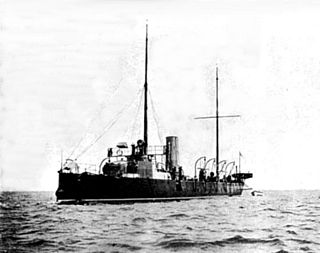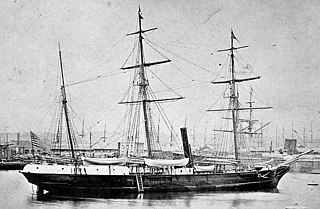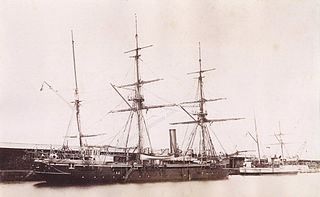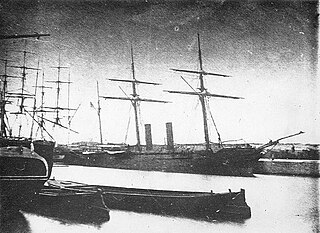
HMS Beagle was a wooden-hulled Arrow-class gunvessel second-class screw gunvessel launched in 1854 and sold in 1863. She was the third vessel of the Royal Navy to use the name.

The Algerine-class gunboats were a class of six 3-gun wooden gunboats built for the Royal Navy in 1857. A further pair were built in India for the Bombay Marine in 1859.

The Arrow class comprised six second-class screw-driven vessels built as despatch vessels for the Royal Navy in 1854, mounting 6 guns. In 1856 they were redesignated as second-class gunvessels.

HMS Rattlesnake was a unique design of torpedo gunboat of the Royal Navy. A result of the Russian war scare of 1885, she was designed by Nathaniel Barnaby that year and built by Laird Brothers, of Birkenhead. Quickly made obsolete by the new torpedo boat destroyers, she became an experimental submarine target ship in 1906, and was sold in 1910.

HMS Surprise was a Vigilant-class gunvessel of the Royal Navy. She was launched at Blackwall Yard, London in 1856 and broken up in Plymouth in 1866.

The Vigilant-class gunvessel of the Royal Navy was an enlarged version of the Arrow-class gunvessel of 1854. Both classes were designed for shallow-water operations in the Baltic and Black Seas during the Crimean War. Fourteen of the class were completed, but were ready too late to take part in that conflict. Cormorant was sunk in action at the Taku Forts, Osprey was wrecked on the coast of Africa in 1867 and the rest were all sold during the 1860s, with Sparrowhawk lasting until 1872.

HMS Mullett was a Royal Navy 5-gun Philomel-class wooden screw gunvessel launched in 1860. She served on the coast of West Africa and on the North America and West Indies Station before being sold in 1872 at Hong Kong for mercantile use. As the sailing ship Formosa she sailed in the Far East before being converted to a magazine in Melbourne.

The Condor-class gunvessel was a class of four Royal Navy composite gunvessels of 3 guns, built between 1876 and 1877. They were all hulked or sold before 1893, giving them an active life of less than 15 years.

HMS Sparrowhawk was a Vigilant-class second-class despatch/gunvessel launched on 9 February 1856 at Limehouse, England and served at various stations in the Far East. By the spring of 1865, her rig was a converted to that of a three-masted barque. She was sold in 1872, converted to a sailing barque in mercantile service, and was later a coal lighter in Australia.

HMS Eclipse was a 4-gun Cormorant-class first class gunvessel launched in 1860 from the shipyard of J. Scott Russell & Co., Millwall. She served on the Australia Station, took part in the Second Taranaki War, including contributing men to a naval brigade which attacked the Maori stronghold at Gate Pā. The entire class were never satisfactory as gunvessels, partly due to their excessive draught, and Eclipse was broken up at Sheerness in 1867, only 7 years after her launch.

The Philomel-class gunvessel was a class of wooden-hulled screw-driven second-class gunvessels built for the Royal Navy between 1859 and 1867, of which 26 were ordered but only 20 completed. They had a mixed history, with some serving for as little as 5 years, and others surviving into the 1880s. Two of the class were sold and used as Arctic exploration vessels, both eventually being lost in the ice.

HMS Myrmidon was a Cormorant-class gunvessel of the Royal Navy, built at Chatham Dockyard and launched in 1867. She served on the North America and West Indies Station and surveyed parts of the Australian coast before being sold at Hong Kong in 1889.

The Algerine-class gunvessel was a class of three Royal Navy composite gunvessels built in 1880. Two of them were sold after only ten years of service, but the other was converted to a survey ship before commissioning and survived in this role until 1907.

Intrepid-class gunvessels were a class of six Royal Navy first-class wooden gunvessels built in 1855-56. They were rated as sloops from 1859 to 1862, and were scrapped by 1865. Victor was sold to the Confederate States of America as the raider CSS Rappahannock, but she was interned by the French at Calais and never fulfilled her intended function.

The Jackal-class gunvessel was a class of two second-class iron paddle gunvessels built for the Royal Navy in the mid 1840s. They served in the Mediterranean and South Atlantic, and latterly on fishery protection duties off Scotland.

The Cormorant-class gunvessels were a class of 4-gun first-class gunvessels built for the Royal Navy in the 1860s. They were somewhat unsuccessful; intended for shore bombardment in shallow water, they exceeded their design draft by 50%. Seven of the 13 ships ordered were suspended, with 3 finished or converted as survey ships and the other 4 cancelled. Racehorse was wrecked after only 4 years, and those ships that were completed as planned had short operational lives, in some cases less than 10 years. The survey vessels lasted longest, with the last ship of the class, Sylvia, being broken up in 1890.
HMS Kestrel was a Clown-class gunboat of the Royal Navy. She was launched in 1856, serving in China and Japan in the 1850s and 1860s. She saw action during the Second Opium War and the Taiping Rebellion.
HMS Hardy was a Albacore-class gunboat of the Royal Navy, notable for her action during the British involvement in the Taiping Rebellion.

HMS Wasp was an Archer type sloop ordered on 25 April 1847 from Deptford Dockyard. Two references stipulate that Parthian, ordered with Archer the year prior was renamed Wasp when ordered as a sloop. However, Parthian remained on the books at Deptford, as a Rifleman type gunvessel until cancelled in June 1849. Therefore Wasp was a new build. She served on many different stations during her career, including West Coast of Africa, in the Mediterranean and Black Sea during the Russian War of 1854 - 55, on the South East Coast of America, Cape of Good Hope where she went aground twice and the East Indies before being sold for breaking in December 1869.












